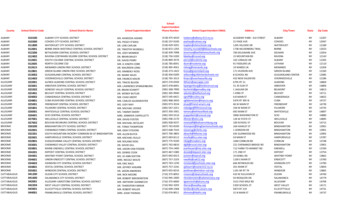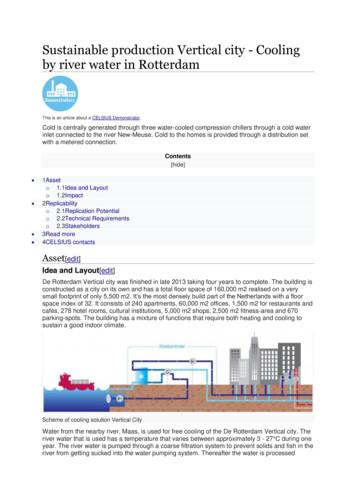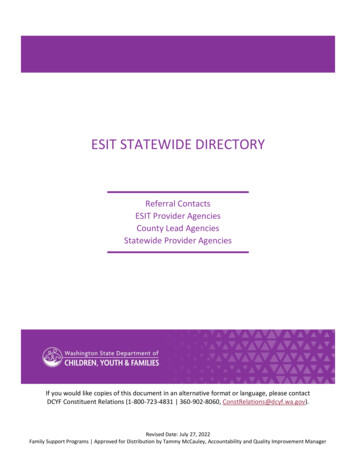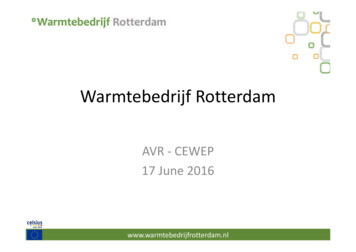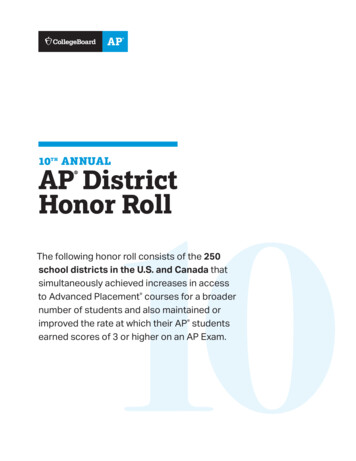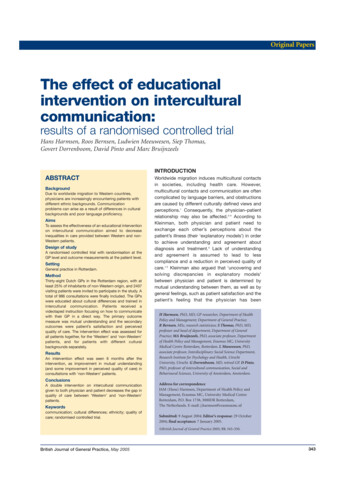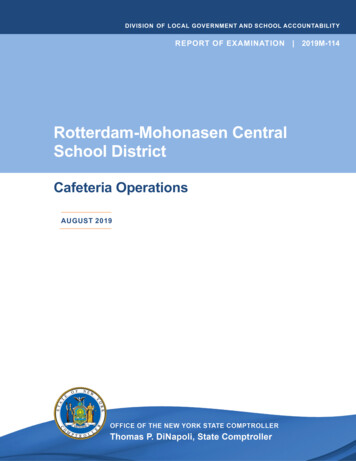
Transcription
DIVISION OF LOCAL GOVERNMENT AND SCHOOL ACCOUNTABILITYREPORT OF EXAMINATIONRotterdam-Mohonasen CentralSchool DistrictCafeteria OperationsAUGUST 2019 2019M-114
ContentsReport Highlights . . . . . . . . . . . . . . . . . . . . . . . . . . . . . 1Cafeteria Expenditures . . . . . . . . . . . . . . . . . . . . . . . . . . 2How Should District Officials Account For and Monitor CafeteriaExpenditures? . . . . . . . . . . . . . . . . . . . . . . . . . . . . . . 2District Officials Did Not Account For All Cafeteria ExpendituresAppropriately. . . . . . . . . . . . . . . . . . . . . . . . . . . . . . . 2District Officials Did Not Effectively Monitor CafeteriaExpenditures. . . . . . . . . . . . . . . . . . . . . . . . . . . . . . . 3District Officials Generally Purchased Cafeteria Items at theLowest Cost . . . . . . . . . . . . . . . . . . . . . . . . . . . . . . . 4What Do We Recommend? . . . . . . . . . . . . . . . . . . . . . . . 5Appendix A – Response From District Officials . . . . . . . . . . . . . 6Appendix B – Audit Methodology and Standards . . . . . . . . . . . . 9Appendix C – Resources and Services. . . . . . . . . . . . . . . . . 11
Report HighlightsRotterdam-Mohonasen Central School DistrictAudit ObjectiveDetermine if District officials are effectivelymanaging cafeteria expenditures.Key FindingsllThe District Treasurer (Treasurer) didnot account for health insurance benefitsprovided to cafeteria employees in thecafeteria fund.llNo one at the District calculated the cost orrevenue-per-meal equivalent (ME).llAlthough District officials selected theircafeteria vendors after advertising forcompetitive bids, District officials could havesaved over 21,000 by purchasing milkthrough a different vendor.Key RecommendationsllThe Treasurer should account for allcafeteria expenditures in the cafeteria fund.llDistrict officials should calculate andmonitor cost- and revenue-per-ME.llThe food service supervisor should reviewthe New York Office of General Services(OGS) cooperative bids to ensure allcafeteria food and supplies are purchasedin the most economical manner.District officials generally agreed with ourrecommendations and indicated they planned toinitiate corrective action.BackgroundThe Rotterdam-Mohonasen Central SchoolDistrict (District) serves the Towns of Colonieand Guilderland in Albany County and theTown of Rotterdam in Schenectady County.The District is governed by the sevenmember Board of Education (Board).The Board has overall responsibility overthe District’s financial and educationalaffairs. The Superintendent of Schools isthe District’s chief executive officer andis responsible, along with the AssistantSuperintendent of Business and otheradministrative staff, for the District’s dayto-day management under the direction ofthe Board. The Treasurer is responsiblefor administering finances and accountingrecords and reports. The food servicesupervisor is responsible for managing theDistrict’s six cafeterias and 32 cafeteriaemployees.Quick Facts2018-19 StudentEnrollment2,8612018-19 General FundAppropriations 53 million2018-19 School LunchFund Appropriations 1.3 millionAudit PeriodJuly 1, 2017 through March 31, 2019.We extended our audit period to July 1, 2015to analyze financial trends.Of f ic e of t he New York State Comptroller1
Cafeteria ExpendituresHow Should District Officials Account For and Monitor CafeteriaExpenditures?District officials are responsible for managing school lunch operations. Thisincludes ensuring there are sufficient revenues to meet current expenditures.The cafeteria fund is a special revenue fund used to account for and reporttransactions of school district breakfast, lunch and milk programs. All directexpenditures1 of a district’s food service program are paid from this fund.Therefore, the cost of health insurance benefits provided to cafeteria employeesshould be accounted for in this fund. A board can choose to subsidize cafeteriaoperations with a transfer from the general fund. However, in accordance withthe New York State Education Department budgeting handbook, a general fundsubsidy of the cafeteria fund is required to be approved by district taxpayers.Additionally, a district is not allowed to increase a taxpayer approved general fundsubsidy to the cafeteria fund without voter authorization.Officials should monitor and analyze operations to identify potential efficiencies.For example, comparing the cost-per-ME,2 to the revenue-per-ME helps officialsset appropriate prices. Also, officials should obtain cafeteria goods at the bestpossible price. Generally, New York State General Municipal Law3 requiresdistricts to advertise for competitive bids when procurements exceed 20,000.Alternatively, OGS makes certain contracts for the procurement of commoditiessuch as food products and supplies available to school districts. By using OGScontracts when the prices are the most advantageous, districts can makepurchases at the same prices and terms as New York State and save money.When employee productivity, meal costs, expenditures and revenues are properlycontrolled and monitored, cafeteria operations may be able to achieve resultscloser to break-even and reduce reliance on general fund subsidies.District Officials Did Not Account For All Cafeteria ExpendituresAppropriatelyThe District reported cafeteria related health insurance expenditures of 43,746in 2015-16, 115,724 in 2016-17 and 148,426 in 2017-18 in the general fund.This occurred because District officials were aware that the cafeteria fundwould be unable to pay all its expenditures without assistance from the generalfund and made a choice to charge the cafeteria fund only 2,500 per month forexpenditures for health insurance with the balance of cafeteria fund related healthinsurance costs to be paid by the general fund.1 Direct expenditures include salaries, wages and fringe benefits for the cafeteria employees and the cost offood and supplies.2 An ME includes a conversion of the number of breakfasts and à la carte revenues into an equivalent numberof lunches. A single lunch is the standard by which all measures are calculated.3 General Municipal Law, Section 1032Of f ic e of t he New York State Comptroller
The correct method would have been to budget for the full cost of cafeteria healthinsurance in the cafeteria fund and provide for a general fund transfer to subsidizethe cafeteria fund in the proposed budget subject to voter approval. The AssistantSuperintendent of Business stated he was unaware of the requirement for generalfund subsidies to the cafeteria fund to be approved by the voters.As a result of reporting cafeteria related costs in the general fund, the District’sfinancial records and reports are not accurate. The misallocation of healthinsurance expenditures has masked the actual operating deficits in the cafeteriafund and made it appear that the cafeteria fund was not receiving an indirecttransfer from the general fund. Further, if the cafeteria fund’s operations wereproperly accounted for, the District would have depleted the cafeteria fundbalance during 2016-17 and currently have a negative fund balance of 393,551.Figure 1: Re-Calculated Operating Surplus/(Deficit) and Fund Balance2015-16Restated Opening FundBalance2016-172017-182018-19a 51,319( 123,141)( 312,264)( 31,367)( 58,736)( 40,697) 52,772 43,746 115,724 148,426 134,059( 75,113)( 174,460)( 189,123)( 81,287)Reported Ending FundBalance 95,065 36,329( 4,368)b 48,404bRe-Calculated EndingFund Balance 51,319( 123,141)( 312,264)( 393,551)Reported esRe-CalculatedOperating Surplus/(Deficit)a Up to March 31, 2019b Excludes a transfer from the general fund of 4,368District Officials Did Not Effectively Monitor Cafeteria ExpendituresThe food service supervisor does not calculate cost- or revenue-per-ME. Wecalculated the cost and revenue-per-ME. From 2015-16 through 2017-18,the cost-per-ME increased 11 percent while the revenue increased 3 percent,excluding transfers from the general fund and including cafeteria related healthinsurance expenditures paid by the general fund; and the costs exceededrevenues by 50 cents per-ME as of 2017-18.Of f ic e of t he New York State Comptroller3
Figure 2: Profit and Loss per-ME2015-162016-172017-18Food Cost-per-ME 1.61 1.61 1.61Labor Cost-per-ME 1.78 2.05 2.16Supply Cost-per-ME 0.18 0.19 0.21Total Cost-per-ME 3.57 3.85 3.98Revenue-per-ME 3.37 3.38 3.48( 0.20)( 0.47)( 0.50)Profit/(Loss)-per-METhe food service supervisor stated she has not calculated the cost or revenueper-ME because she was unaware how to perform these calculations. While shedoes have access to both monthly profit and loss statements prepared by theTreasurer and ME reports from the cafeteria’s point-of-sale system, the profit andloss reports do not include the cafeteria related health insurance expenditurespaid by the general fund that are needed to accurately calculate the cost-per-ME.Despite the fact a cost-per-ME is not calculated, District officials are aware of thecafeteria fund’s operating deficits and have tried to decrease costs or increaserevenues. For example, District officials have not replaced certain employeeswhen they resigned or retired to help lower personal service costs.Although the District has attempted to control costs by reducing staffing levels,without periodically monitoring and analyzing school lunch fund operations, theschool lunch fund’s current level of reliance on the aforementioned unreportedgeneral fund subsidies will continue.District Officials Generally Purchased Cafeteria Items at the LowestCostDistrict officials selected their cafeteria vendors after advertising for competitivebids. In early May, the District sends out invitations to bid in the District’s officialnewspaper and by mailing letters to vendors that have requested to be providedsuch correspondence. Once the bids are publicly opened and read, the foodservice supervisor reviews the bids and makes recommendations on who theBoard should select as cafeteria vendors, based on lowest price or best value.We compared the prices of seven food items purchased through competitivebid to the OGS cooperative bid in 2017-18 and 2018-19 and found the Districtgenerally obtained the best price. We also compared milk purchased throughcompetitive bidding in 2017-18 and 2018-19 and found that District officials couldhave saved over 21,000 by purchasing milk through a different vendor utilizingthe OGS cooperative bid.4Of f ic e of t he New York State Comptroller
The food service supervisor was aware that the District could utilize contractsfrom OGS for cafeteria purchases. However, she explained that she discontinuedlooking at OGS contracts in 2014 because the District had been receivingbetter prices through competitive bidding. While most purchases were made ina prudent and economical manner, when District officials do not review OGScooperative bids on a regular basis, they cannot ensure that they are actuallypurchasing goods in the most cost effective manner.What Do We Recommend?The Treasurer should:1. Account for all cafeteria related expenditures in the cafeteria fund.District officials should:2. Include an appropriation to transfer money from the general fund tothe cafeteria fund in the proposed budget subject to voter approval ifthey intend for the general fund to continue subsidizing cafeteria fundoperations.3. Periodically calculate and monitor cost- and revenue-per-ME, and exploremethods to decrease expenditures and increase revenues.The food service supervisor should:4. Review OGS cooperative bids on a regular basis to ensure all cafeteriafood and supplies are purchased in the most economical manner.Of f ic e of t he New York State Comptroller5
Appendix A: Response From District Officials6Of f ic e of t he New York State Comptroller
Of f ic e of t he New York State Comptroller7
8Of f ic e of t he New York State Comptroller
Appendix B: Audit Methodology and StandardsWe conducted this audit pursuant to Article V, Section 1 of the State Constitutionand the State Comptroller’s authority as set forth in Article 3 of the New YorkState General Municipal Law. To achieve the audit objective and obtain valid auditevidence, our audit procedures included the following:llWe interviewed District officials and reviewed Board minutes to gain anunderstanding of cafeteria operations including accounting, cost monitoringand purchasing.llWe reviewed paycheck information from the accounting system to determinewhich cafeteria employees received a paycheck in 2015-16 through 2018-19.We then reviewed health insurance bills to the District to determine whichof the cafeteria employees received health and/or dental insurance anddocumented the monthly premiums.llWe determined the under-reported medical insurance expenditure bycalculating the actual yearly employer cost less the reported medicalinsurance expenditures and then recalculated the actual operating deficitand fund balance when adding the under-reported medical insuranceexpenditures to the actual results of operations from the appropriation andrevenue status reports.llWe calculated MEs for 2015-16 through 2017-18. See the UniversityOf Mississippi’s Institute Of Child Nutrition’s Financial Management forDirector’s Section Financial Management Information System (FMIS Booklet,2nd Edition at https://theicn.org/school-nutrition-programs/, pages 59 through61).llWe calculated the costs and revenues of the school lunch fund per-ME for2015-16 through 2017-18, and analyzed the results for trends in the per-MEcosts and revenues and calculated the per-ME results of operations.llWe interviewed the food service supervisor to determine which items werepurchased often and in large quantities. From these interviews, we usedour professional judgment to select spicy chicken patties, popcorn chicken,yogurt, frozen bagels, fruit juices (orange, grape and apple). We also usedour professional judgment to select milk and fresh bread products. Wecompared the prices to the OGS cooperative bids to determine whetherthe District purchased these items at the best possible price and, if not, wecalculated the amount the District could have saved.We conducted this performance audit in accordance with GAGAS (generallyaccepted government auditing standards). Those standards require that weplan and perform the audit to obtain sufficient, appropriate evidence to provide areasonable basis for our findings and conclusions based on our audit objective.We believe that the evidence obtained provides a reasonable basis for ourfindings and conclusions based on our audit objective.Of f ic e of t he New York State Comptroller9
Unless otherwise indicated in this report, samples for testing were selectedbased on professional judgment, as it was not the intent to project the resultsonto the entire population. Where applicable, information is presented concerningthe value and/or size of the relevant population and the sample selected forexamination.A written corrective action plan (CAP) that addresses the findings andrecommendations in this report must be prepared and provided to our office within90 days, pursuant to Section 35 of General Municipal Law, Section 2116-1(3)(c) of New York State Education Law and Section 170.12 of the Regulations ofthe Commissioner of Education. To the extent practicable, implementation of theCAP must begin by the end of the fiscal year. For more information on preparingand filing your CAP, please refer to our brochure, Responding to an OSC AuditReport, which you received with the draft audit report. We encourage the Board tomake the CAP available for public review in the District Clerk’s office.10Of f ic e of t he New York State Comptroller
Appendix C: Resources and ServicesRegional Office Directorywww.osc.state.ny.us/localgov/regional directory.pdfCost-Saving Ideas – Resources, advice and assistance on cost-saving x.htmFiscal Stress Monitoring – Resources for local government officialsexperiencing fiscal ing/index.htmLocal Government Management Guides – Series of publications that includetechnical information and suggested practices for local government ctg.htm#lgmgPlanning and Budgeting Guides – Resources for developing multiyear financial,capital, strategic and other .htmProtecting Sensitive Data and Other Local Government Assets – A nontechnical cybersecurity guide for local government urity-guide.pdfRequired Reporting – Information and resources for reports and forms that arefiled with the Office of the State ng/index.htmResearch Reports/Publications – Reports on major policy issues facing localgovernments and State pubs/index.htmTraining – Resources for local government officials on in-person and onlinetraining opportunities on a wide range of tmOf f ic e of t he New York State Comptroller11
ContactOffice of the New York State ComptrollerDivision of Local Government and School Accountability110 State Street, 12th Floor, Albany, New York 12236Tel: (518) 474-4037 Fax: (518) 486-6479 Email: dex.htmLocal Government and School Accountability Help Line: (866) 321-8503GLENS FALLS REGIONAL OFFICE – Jeffrey P. Leonard, Chief ExaminerOne Broad Street Plaza Glens Falls, New York 12801-4396Tel (518) 793-0057 Fax (518) 793-5797 Email: Muni-GlensFalls@osc.ny.govServing: Albany, Clinton, Essex, Franklin, Fulton, Hamilton, Montgomery, Rensselaer, Saratoga,Schenectady, Warren, Washington countiesLike us on Facebook at facebook.com/nyscomptrollerFollow us on Twitter @nyscomptroller
The Rotterdam-Mohonasen Central School District (District) serves the Towns of Colonie and Guilderland in Albany County and the Town of Rotterdam in Schenectady County. The District is governed by the seven-member Board of Education (Board). The Board has overall responsibility over the District's financial and educational affairs.
